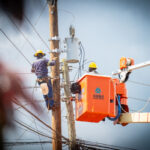On a blustery weekday along the boulder-lined Palisades stretch, water booted and barefooted volunteers are wading along the perimeter of the Kingston Harbour. The ready-to-work contingent comprising employees from JPS and the National Environmental and Planning Agency (NEPA), joined by several residents from the neighbouring Port Royal community, were out to plant 270 mangrove saplings at the Sturridge Park lot.
The recent Friday morning environmental group project is the latest chapter of a $7-million, five-year partnership signed in February 2023 between the JPS Foundation and NEPA, as part of the latter’s Adopt a Mangrove program, to restore mangroves lost to human interference and pollution from the harbour. “Today, red mangroves were being planted at the site which were nursed at the University of the West Indies Port Royal Marine Lab,” informed Italee Patterson, environmental officer at NEPA with oversight management for the Palisadoes/Port Royal protected area and the Blue and John Crow Mountain National Park. Thirty saplings were planted weeks earlier, Patterson shared, bringing the current total to 300.
Mesh fencing was installed at the Sturridge Park site in December last year to prevent debris from coming ashore. Two months later, NEPA officers and team members from the JPS Foundation’s Volunteers on Location to Serve (VOLTS) cadre returned and together carried out a clean-up exercise to remove solid waste in preparation to plant these mangrove saplings.
Outlining the plant’s environmental significance, NEPA’s Patterson explained that mangroves are critical for several reasons, among them proving a unique habitat for a diverse range of fish, birds, and invertebrates.
“They serve as nurseries for many marine species which use these areas for breeding and juvenile development. Mangroves act as natural barriers against storm surges and erosion. Their dense root systems stabilize shorelines and prevent land loss, protecting inland areas from the impact of extreme weather events.”
The environmental officer added that mangroves are highly efficient at capturing and storing carbon dioxide from the atmosphere, which make them significant carbon sinks. “This helps mitigate the effects of climate change and maintains ecological balance.”
Also ankle-deep in the lapping swash was JPS Foundation officer Samora Bain, digging holes alongside her colleagues to plant the saplings.
“We have a pretty good turnout here, the same as in the last time. They were excited to return when they heard the mangroves were being prepared to be planted and wanted to get back on board,” she relayed.
For Bain, there was resonance being part of this mangrove planting exercise. “When I attended St. Andrew High School, I was in a leadership role in the environmental club. I’m also very aware of the general environment and at home, I separate food from actual garbage,” she said.
“Working in a foundation means that you do heart projects and so it’s always good especially when you do a follow-up project,” Bain added. “I was excited about coming back to participate in the planting. For me it is personally fulfilling from that perspective, so it’s not a one-off activity, you can see some continuity and impact over time.”




